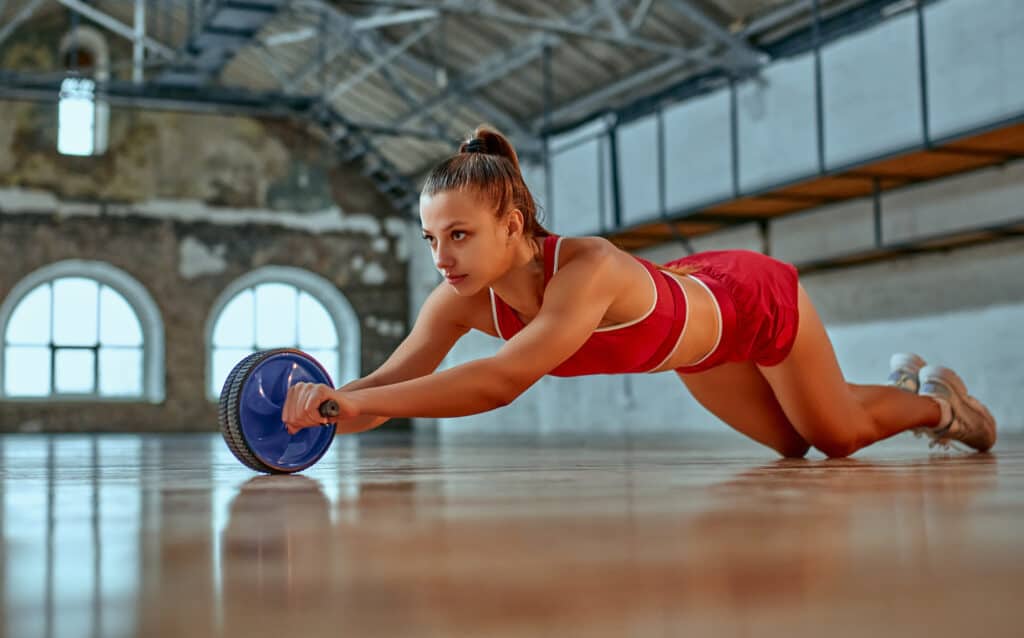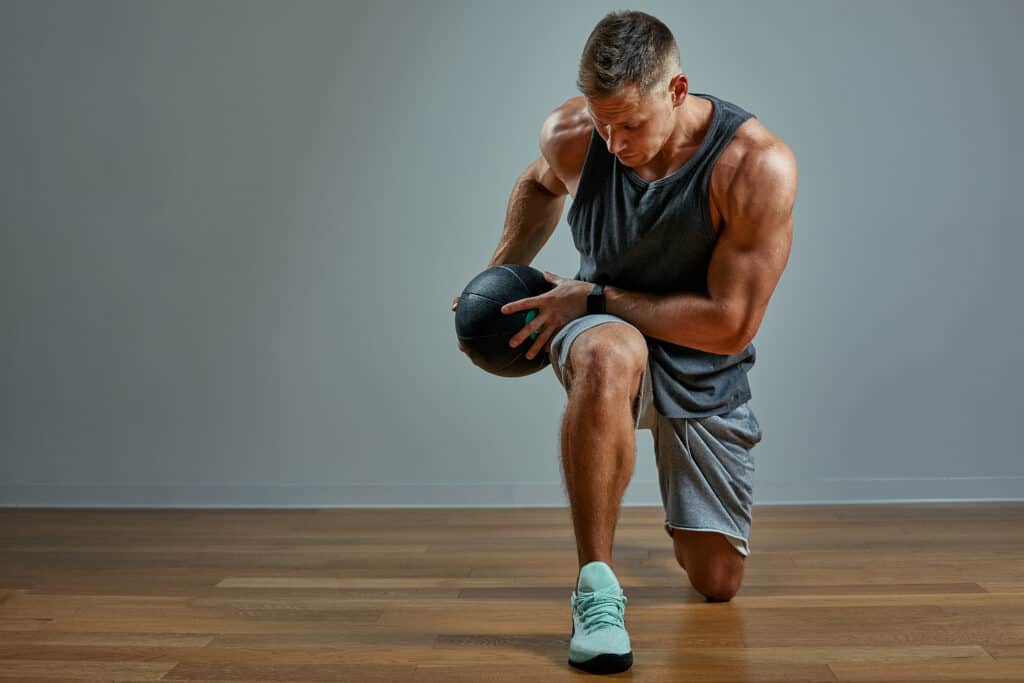We know that upright or standing exercises are usually some of the best movements you can perform. The majority of the exercises in a workout are typically done while standing or lying down on a bench. A standing exercise can mimic everyday activity and many sport-specific movements. Incorporating exercises that put the body in non-traditional positions, such as kneeling, can be extremely beneficial as well. Many of the exercises you perform standing or seated can also be executed from either a kneeling or a half kneeling position. For the purposes of this article, we will focus on the last two, tall kneeling and half kneeling positions.
Kneeling exercises can be added to an exercise routine because you’re working around an issue, like a foot injury. In addition, positioning the body in a kneeling or half-kneeling position can be beneficial from a flexibility or mobility stand point as well. Finally, working the body while maintaining these positions, comes with an added bonus, they stress the muscles making up the core.
Kneeling Exercises Offer a Great Core Workout
A kettlebell overhead press, curling dumbbells or executing a landmine press (see this recent Jefit Instagram post on how to do it), when performed from a kneeling position, offers an added bonus. The by-product is a great core workout. Keep in mind, when your lower legs are taken out of the equation, your abs, glutes, and lower back muscles have to really engage or “fire” or you’ll lose your balance.
Maintain Proper Body Position
Let’s start with the tall kneeling position. Begin in a kneeling position with your bodyweight evenly distributed on both knees. Keep an 8-12 inch gap between the knees. The key with this, and the half kneeling exercise, is core engagement. Work on maintaining a tall posture throughout. There is no forward/backward or side-to-side bending with any exercise performed from this base position. Stay “locked and loaded” during any kneeling exercise.
The half kneeling position requires the same tall posture and core focus. In this position, though, one leg is bent at a right angle out in front of the body. The other leg also maintains a right angle at the knee but that knee is directly below your hip. A half kneeling position, in and of itself, is a great position to maintain when trying to stretch the quadriceps and hip flexors. In order to maintain a strong base of support, make sure there is adequate space between the legs. The closer you bring your inner thighs (like trying to balancing on a 2×4) the more difficult the exercise becomes. Exercises performed from this position are also great for improving thoracic spine mobility.

Three Tall Kneeling Exercises to Try
- Tall Kneeling Bicep Curl – This is pretty much as it sounds. Start in a kneeling position. While on your knees, perform either a bicep curl, alternating bicep or hammer curl, using dumbbells or even a kettlebell.
- Tall Kneeling Overhead Press – Again, pretty much as it sounds. You can go with a one-arm or bilateral movement here. Make sure when you press any weight overhead, you’re “locked-in” and the extended arm is back near your ear.
- Tall Kneeling Trunk Flexion – This is basically a tall kneeling partial sit-up. Position yourself in front of a cable machine (the machine is behind you). Reach overhead and take hold of the handles or rope. Pull the cables up over the shoulders. Position the handles at upper chest height. From there, flex the trunk performing basically a tall kneeling “partial” sit-up. Perform no more than 30-45 degrees of trunk flexion. Keep in mind, there are other exercises that involve more trunk flexion where you basically touch the elbows to the thighs. This, however, is a different exercise.
Three Half Kneeling Exercises to Try
- Half Kneeling Pull or Press – This could include a single or double arm pull or press exercise. For example, a pull exercise would be something like a one or two arm lat pull exercise. This could include a vertical or horizontal pull. The press movement is also a unilateral or bilateral pressing movement using a kettlebell or dumbbell.
- Half Kneeling Pallof Press – This is a great “anti-rotational” core exercise. Get in position with the cable machine or exercise band to the side of you and drop to one knee. Your position should resemble a finished lunge, but with the back knee grounded. Press the cable or band handle out in front of you and hold for five to ten seconds, resisting the rotation, then return the handle back to your lower chest and repeat for desired repetitions.
- Half Kneeling Rotational Exercises – This can be done with a medicine ball, off a cable machine or using a GIANT band or exercise band. Perform your rotational movement in towards the knee that is bent in front of the body.
Transitional Kneeling Movements
Transitional refers to any type of movement performed from a tall kneeling position. Meaning, you would start in a kneeling position but move away or jump out of that base position.
- Ab Roller (see photo above) – you can use a traditional ab roller for this one. There is also an option for using an Olympic bar or EZ-curl bar instead. Finally, you can try sliders or a towel placed under the hands if non of the above are available.
- Tall Kneeling to Squat – This is a great explosive, bodyweight exercise to add to your training program ever so often. Begin in tall kneeling position, where you’re positioned on your knees or even resting on your shins. From there, explode into a deep squat position and repeat for desired repetitions. This can also be perform in “slow motion”, one leg at a time, therefore becoming more of a hip mobility exercise.
- Kneeling Leg Curl – You can use a partner for this one or secure the legs under a heavy piece of equipment that won’t move. Let the body slowly fall towards the ground, as the hamstrings lengthen. Then you “pull” the body back to the starting position using the hamstrings. You can also push of the ground if needed.
Change can be good for the body. With that said, change body positions periodically, incorporate various planes of movement, change ground surfaces, or transition from bi-lateral to uni-lateral exercises in your training program. Of course, try adding in a few kneeling exercises while you’re at it. How often? It really depends on your training goals. A good start may be to change things up every eight weeks or so and monitor how your body responds to any such changes.
Stay Strong Together
Jefit, was named best strength training app for 2024, by PC Magazine, Forbes, Garage Gym Reviews and many others. The award-winning Jefit app comes equipped with a customizable workout planner, training log, the ability to track data and share workouts with friends. Take advantage of Jefit’s huge exercise database for your strength workouts. Visit our members-only Facebook group. Connect with like-minded people, share tips, and advice to help get closer to reaching your fitness goals.
- Whey vs. Casein: What’s the Best Protein for Building Muscle - April 18, 2025
- Four Popular Jefit Chest Exercises Backed by Science - April 16, 2025
- 4 Must-Have Exercises Backed by Science for a Full-Body Workout - April 14, 2025
